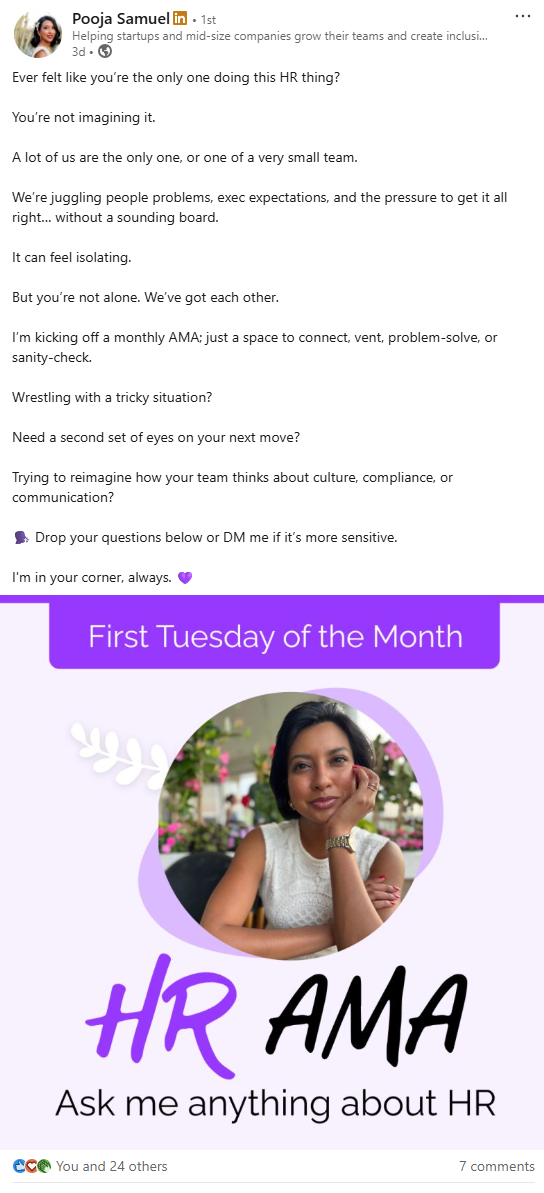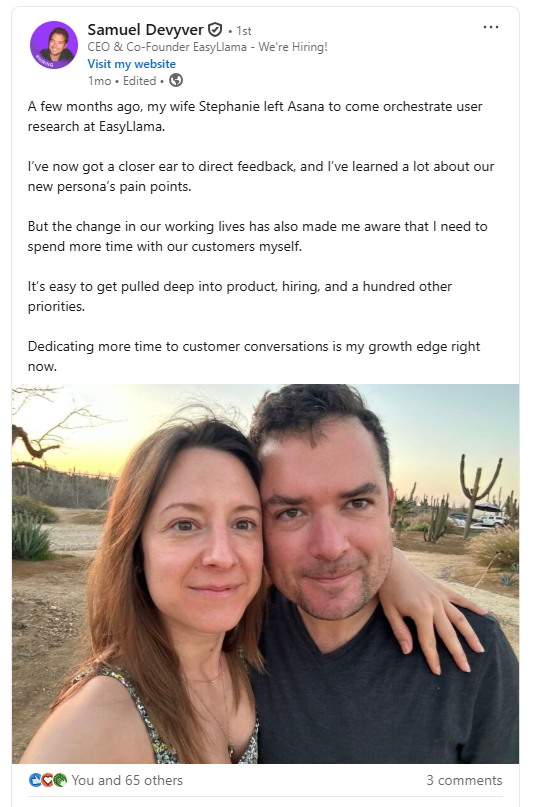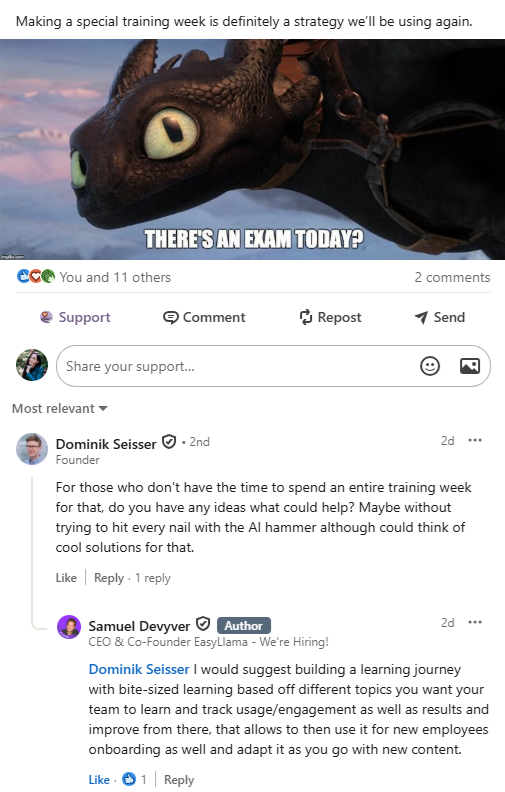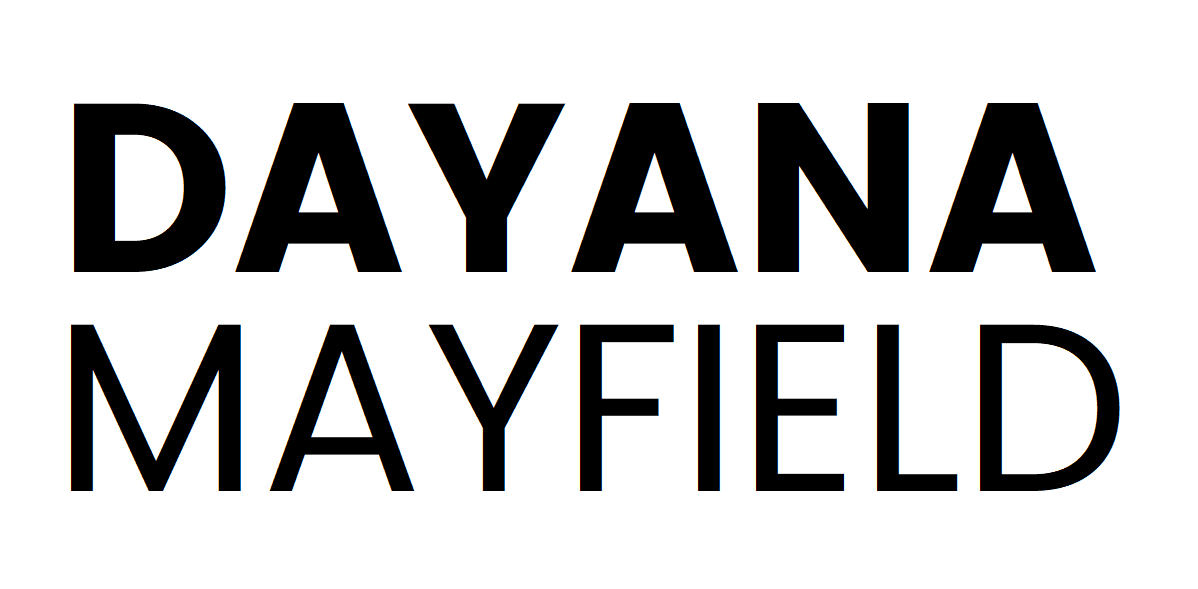If you’re reading this, chances are you know LinkedIn should be your biggest organic channel. But you’re also probably tired of hearing recycled tips like “be authentic!” or “post more often!” without any clue how to do that in a way that actually moves the needle for your SaaS brand.
I ghostwrite LinkedIn posts for founders and executives who’d rather spend their day running the business, not staring at a blinking cursor. As a SaaS copywriter, I’ve led dozens of focused content workshops, combed through half-finished thoughts, and turned them into posts that drive thousands of impressions, real conversation, and pipeline.
Below, you’ll find my real process. How I pull stories out of SaaS leaders’ brains, shape them for LinkedIn, and make sure they feel like them (not a generic “thought leader”).
If you want posts that actually get read, these 10 tips are your unfair advantage.
Why LinkedIn copywriting deserves your attention
Many SaaS founders think of LinkedIn as a nice-to-have, a place for quick company updates or the occasional humblebrag when they close a round. But what they’re missing is that LinkedIn isn’t about them. It’s about the reader.
Good LinkedIn copywriting respects the audience’s time and attention. It earns every second of the scroll. It solves real problems, shows real personality, and does one thing above all: it builds trust before you ask for anything in return.
If you’re serious about using LinkedIn to open doors for hiring, investment, and partnership opportunities, then you need to treat your posts like a product. They need a point, a voice, and a payoff.
Let’s break down how I do that.
1. Start with a real conversation
If you’re ghostwriting for a founder or executive, never start cold. Schedule an interview at least twice a month, and show up prepared with real prompts: ask about a recent win, a lesson learned, a mistake they’d handle differently, or a trend they’re seeing before everyone else.
That call is where you’ll find the gold: the phrases, the voice, the moments that make your posts feel like them and not like generic thought leadership.
If you’re writing your own content, the process is the same, except you’re the one talking. I tell solo founders to take a walk and record themselves talking through an idea. No slides, no notes, just hit record on your phone and rant out loud like you’re explaining it to a friend.
When you’re back at your desk, drop the transcript into ChatGPT or a doc, then pull out every single idea, question, and tangent. One 20-minute walk can easily fuel your next month of posts.
2. Make it about them, not you
Every SaaS founder wants to share their next big milestone, and there’s nothing wrong with that. But if every single post is just an update about you, it’s easy for your audience to tune out. The same thing goes for storytelling: yes, LinkedIn loves a good story, but only when it means something to the reader too.
People scroll because they’re looking for something that helps them, such as a tip they can use, a perspective they haven’t thought about, a feeling that makes them say, “Oh, I’m not alone in this.”
So instead of just telling your story for the sake of it, frame it so the reader sees themselves in it. Take that Series A announcement and talk about the mistake you made when pitching, so other founders can avoid it.
Share the moment you almost lost a big customer, but break down exactly how you handled it so your audience walks away with something useful.
In this example post that I wrote, we’re ramping up LinkedIn by kickstarting with a promise to support our target audience, who’s always supporting everyone else and is often overlooked and stretched too thin.

3. Test out different hooks
Your first line is everything.
On LinkedIn, you don’t get a catchy image or a paid placement to force attention. You get two lines before the “see more” cut.
If your first line doesn’t earn the click, you lose.
I push every client to test different types of hooks:
-
Ask a provocative question – Example: “Would you trust your biggest client renewal to a junior rep with zero training?”
-
Drop an unexpected stat – Example: “72% of B2B buyers ghost sales teams after the first call. Here’s how we fixed that.”
-
Use a vivid image or micro-story – Example: “I was sitting in my car outside the office, sweating through my shirt, wondering if I should walk back in and quit on the spot.”
-
Start mid-thought so the reader needs to know more – Example: “I realized our entire onboarding flow was costing us more customers than we were closing.”
- State exactly the value the reader will get from the jump – Example: “If you’re losing deals at the proposal stage, steal this 3-step fix we use to win them back.”
Think about what would stop you from scrolling. It’s usually something that sparks a little curiosity and promises there’s more worth clicking into.
4. Format for the skim
You are not writing an essay. You are not writing an email newsletter. You are writing for people half-reading on a phone while half-watching Netflix.
If you want your post to be read, not just seen, you need to format it for people who skim:
- Break up long paragraphs into shorter sections.
- Use line breaks to create breathing room.
- One-liners can punch, but mix them with medium-length sentences so it doesn’t feel too choppy or robotic.
- Sometimes a well-placed emoji helps guide the eye.
- And if you’re making a list? Use bullets or numbered lines.
The easier it is to read, the higher the chance they’ll stick around to the end. Readable content beats clever content every time.
5. Use stories over statements
One of my biggest LinkedIn copywriting rules: show, don’t tell.
Don’t say, “We value transparency.” Tell me about the time you admitted to a hiring mistake publicly, and what you did next.
Don’t say, “We put customers first.” Show the DM from a customer who got a Saturday night reply.
Micro-stories are gold because they’re sticky. No one remembers generic advice. They remember that time you almost missed payroll and called every investor you knew.
The more your posts feel like little moments, the more people want to read them, and share them.
Kudos if you can include an informal selfie like this example post I wrote.

Connect the dots to why it matters to your reader. Make sure every story has a takeaway they can apply. If you tell people how you lost your biggest customer once, break down how they can keep theirs. If you talk about a hiring mistake, share how to spot the same red flag. A good story makes your reader nod along and think, “Next time, I’ll do that differently.”
6. Add your real point of view
Too many SaaS execs default to safe, info-dump posts. “Here are the trends. Here’s the data.” Okay… but what do you think about it?
A good post has a take. It stakes out an angle. It might ruffle a few feathers.
Example: Instead of “Here’s the state of B2B buying,” say: “The B2B buying journey is broken, and we’re all partly to blame. Here’s how we fix it.”
Your audience doesn’t need you to repeat the headlines they’ve already seen. They want to know what you see coming next. They want to know why you disagree with the crowd. They want to hear your stake in the ground.
A strong point of view doesn’t mean stirring up controversy for clicks. It means you’re not afraid to be clear about what you believe and what you don’t. Those posts stick because they make people feel something, whether that’s agreement, pushback, or a reason to share.
7. Solve a real, current problem
Want instant traction? Write for someone’s current headache.
A lot of founders post generic “thought leadership.” Meanwhile, their ideal buyers are losing sleep over messy handoffs, churn, or hitting that next revenue milestone.
When I ghostwrite, I listen for problems. What do they keep ranting about on calls? What’s everyone asking in the comments?
If you can write a post that makes someone think, “Wow, this is exactly what I needed today,” you’re winning. That’s the post people save, share, and send to their team. The more immediate the problem, the more immediate the engagement.
For example, in this LinkedIn post I ghostwrote, a reader strikes up a conversation asking for help specific to his situation. The post led to read engagement with a potential customer and the founder had the chance to hint at his product in his response.

8. Give away a time-saving shortcut
I love a good value drop.
Want your LinkedIn copywriting to build real trust? Make your post so useful they feel guilty not hitting “Save.”
Some of my best posts have been simple checklists, question sets, or short scripts founders can swipe.
Give away something practical that saves people time. Founders and execs have frameworks, scripts, swipe files, all tucked away in Notion or floating around in their heads. When you pull one of those out and share it for free, you prove your value instantly.
A short checklist, a one-slide framework, a fill-in-the-blank cold email. People love this stuff because they can put it to work right away. If you’re ghostwriting, always be on the lookout for these hidden gems in your client’s process. If you’re writing for yourself, don’t gatekeep. The fastest way to build credibility is to make your reader’s life easier.
9. Use contrarian angles to stand out
Most posts blend in because they say the same thing everyone else is saying, just with slightly different words. If you want your post to pop out in the feed, find an angle that pushes back a bit.
You don’t need to be a troll. You just need to be honest about what you really think, especially when it’s different from the safe answer. A founder who’s willing to say, “Actually, we stopped doing X — here’s why it worked better for us,” will always get more attention than the one repeating the obvious.
A well-defended hot take shows you’re not just repeating trends — you’re noticing what works and what doesn’t in the real world. Readers respect that. They might even argue with you in the comments, which is great. Disagreement equals reach.
10. Match your voice to your audience’s ears
This is where the ghostwriting magic happens. You can’t just write posts in your own style if you’re ghostwriting for a founder or exec, your job is to make sure it sounds exactly like them, in a way that resonates with the people they’re trying to reach.
A good voice match means you know if they’re naturally warm or blunt, casual or precise. It means you echo the phrases they use on calls. It means you write the same way they’d explain it if they were sitting across from a customer.
And most importantly, you shape it for the audience that’s reading. If they’re speaking to other CEOs, the tone might lean sharp and strategic. If they’re building credibility with mid-level managers, it might be more relatable and encouraging.
The right words and tone means the difference between a post that flops and a post that feels like a real conversation.
The ideal AI-powered LinkedIn copywriting process
So what does this actually look like when it’s running smoothly? Here’s how I break it down for busy SaaS founders and execs, so they get posts that sound like them without ever touching the cursor.
Here’s the quick blueprint I use every week:
-
🔍 Keep a living list of ideas: I maintain an always-growing doc of angles, including short, punchy headlines, story prompts, customer problems, and open-ended questions that match the founder’s goals and audience. This means we never show up to a call cold.
-
🎙️ Run an interview call for fresh raw material: Twice a month, we jump on a focused 30-minute call. I’ll usually pull out 6–8 strong post ideas in a single session just by asking the right questions and nudging the conversation deeper. The best insights always come when the founder’s a bit off-script.
-
📝 Input the transcript into AI, one idea at a time: After the call, I drop the transcript into ChatGPT. I don’t dump the whole thing at once — I break it up, feeding one idea at a time so the AI stays sharp and focused. Each idea becomes a rough draft with a hook, story, and CTA.
-
✏️ Rewrite and polish the draft: Next, I shape the AI draft into a final post. This is where I tighten the voice, smooth out the flow, cut filler, and make sure it really sounds like the client, not like a robot.
-
📌 Layer in frameworks and templates: Not every post needs to start from scratch. Some follow proven structures: a how-to list, a behind-the-scenes breakdown, a quick framework or swipe file to share. I weave these in so the founder’s content mix stays balanced and repeatable.
These steps will help you create posts that attract the right people, feel personal (not generic), and prove real thought leadership, all without the founder needing to write a single line from scratch.
Common LinkedIn copywriting mistakes and how to dodge them
If you take nothing else, take this:
Most LinkedIn posts flop because they’re:
🚫 Too generic: could come from anyone, anywhere.
🚫 Too stiff: sounds like a press release.
🚫 Too self-centered: all about the company, nothing for the reader.
🚫 Too complex: no one wants to decode your jargon or story mid-scroll.
Good LinkedIn copy is:
✅ Specific.
✅ Human.
✅ Useful.
✅ Easy to skim.
If you can tick those four boxes, you’re already ahead of 90% of founders on the feed.
For more tips, check out my SaaS copywriting guide.
The ROI of good LinkedIn copywriting
Here’s the part most SaaS execs miss: LinkedIn doesn’t sell your product. It sells you: your ideas, your vibe, your POV.
When done well, your posts aren’t just content. They’re quiet drip campaigns. They warm up your next investor, your next hire, your next customer — before you ever pitch.
Yes, it takes time. Yes, it takes consistency. But it works.
If you want to do it right, do it like you’d do any other part of your business: with a clear voice, clear goals, and a clear system.
If you’re a SaaS founder or exec who wants LinkedIn posts that actually get read—without doing all the writing yourself—let’s connect. Get in touch with me.

